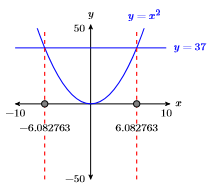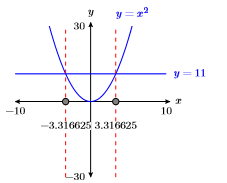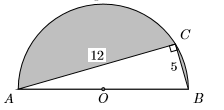8.E: Quadratic Functions (Exercises)
- Page ID
- 19902
\( \newcommand{\vecs}[1]{\overset { \scriptstyle \rightharpoonup} {\mathbf{#1}} } \)
\( \newcommand{\vecd}[1]{\overset{-\!-\!\rightharpoonup}{\vphantom{a}\smash {#1}}} \)
\( \newcommand{\dsum}{\displaystyle\sum\limits} \)
\( \newcommand{\dint}{\displaystyle\int\limits} \)
\( \newcommand{\dlim}{\displaystyle\lim\limits} \)
\( \newcommand{\id}{\mathrm{id}}\) \( \newcommand{\Span}{\mathrm{span}}\)
( \newcommand{\kernel}{\mathrm{null}\,}\) \( \newcommand{\range}{\mathrm{range}\,}\)
\( \newcommand{\RealPart}{\mathrm{Re}}\) \( \newcommand{\ImaginaryPart}{\mathrm{Im}}\)
\( \newcommand{\Argument}{\mathrm{Arg}}\) \( \newcommand{\norm}[1]{\| #1 \|}\)
\( \newcommand{\inner}[2]{\langle #1, #2 \rangle}\)
\( \newcommand{\Span}{\mathrm{span}}\)
\( \newcommand{\id}{\mathrm{id}}\)
\( \newcommand{\Span}{\mathrm{span}}\)
\( \newcommand{\kernel}{\mathrm{null}\,}\)
\( \newcommand{\range}{\mathrm{range}\,}\)
\( \newcommand{\RealPart}{\mathrm{Re}}\)
\( \newcommand{\ImaginaryPart}{\mathrm{Im}}\)
\( \newcommand{\Argument}{\mathrm{Arg}}\)
\( \newcommand{\norm}[1]{\| #1 \|}\)
\( \newcommand{\inner}[2]{\langle #1, #2 \rangle}\)
\( \newcommand{\Span}{\mathrm{span}}\) \( \newcommand{\AA}{\unicode[.8,0]{x212B}}\)
\( \newcommand{\vectorA}[1]{\vec{#1}} % arrow\)
\( \newcommand{\vectorAt}[1]{\vec{\text{#1}}} % arrow\)
\( \newcommand{\vectorB}[1]{\overset { \scriptstyle \rightharpoonup} {\mathbf{#1}} } \)
\( \newcommand{\vectorC}[1]{\textbf{#1}} \)
\( \newcommand{\vectorD}[1]{\overrightarrow{#1}} \)
\( \newcommand{\vectorDt}[1]{\overrightarrow{\text{#1}}} \)
\( \newcommand{\vectE}[1]{\overset{-\!-\!\rightharpoonup}{\vphantom{a}\smash{\mathbf {#1}}}} \)
\( \newcommand{\vecs}[1]{\overset { \scriptstyle \rightharpoonup} {\mathbf{#1}} } \)
\( \newcommand{\vecd}[1]{\overset{-\!-\!\rightharpoonup}{\vphantom{a}\smash {#1}}} \)
\(\newcommand{\avec}{\mathbf a}\) \(\newcommand{\bvec}{\mathbf b}\) \(\newcommand{\cvec}{\mathbf c}\) \(\newcommand{\dvec}{\mathbf d}\) \(\newcommand{\dtil}{\widetilde{\mathbf d}}\) \(\newcommand{\evec}{\mathbf e}\) \(\newcommand{\fvec}{\mathbf f}\) \(\newcommand{\nvec}{\mathbf n}\) \(\newcommand{\pvec}{\mathbf p}\) \(\newcommand{\qvec}{\mathbf q}\) \(\newcommand{\svec}{\mathbf s}\) \(\newcommand{\tvec}{\mathbf t}\) \(\newcommand{\uvec}{\mathbf u}\) \(\newcommand{\vvec}{\mathbf v}\) \(\newcommand{\wvec}{\mathbf w}\) \(\newcommand{\xvec}{\mathbf x}\) \(\newcommand{\yvec}{\mathbf y}\) \(\newcommand{\zvec}{\mathbf z}\) \(\newcommand{\rvec}{\mathbf r}\) \(\newcommand{\mvec}{\mathbf m}\) \(\newcommand{\zerovec}{\mathbf 0}\) \(\newcommand{\onevec}{\mathbf 1}\) \(\newcommand{\real}{\mathbb R}\) \(\newcommand{\twovec}[2]{\left[\begin{array}{r}#1 \\ #2 \end{array}\right]}\) \(\newcommand{\ctwovec}[2]{\left[\begin{array}{c}#1 \\ #2 \end{array}\right]}\) \(\newcommand{\threevec}[3]{\left[\begin{array}{r}#1 \\ #2 \\ #3 \end{array}\right]}\) \(\newcommand{\cthreevec}[3]{\left[\begin{array}{c}#1 \\ #2 \\ #3 \end{array}\right]}\) \(\newcommand{\fourvec}[4]{\left[\begin{array}{r}#1 \\ #2 \\ #3 \\ #4 \end{array}\right]}\) \(\newcommand{\cfourvec}[4]{\left[\begin{array}{c}#1 \\ #2 \\ #3 \\ #4 \end{array}\right]}\) \(\newcommand{\fivevec}[5]{\left[\begin{array}{r}#1 \\ #2 \\ #3 \\ #4 \\ #5 \\ \end{array}\right]}\) \(\newcommand{\cfivevec}[5]{\left[\begin{array}{c}#1 \\ #2 \\ #3 \\ #4 \\ #5 \\ \end{array}\right]}\) \(\newcommand{\mattwo}[4]{\left[\begin{array}{rr}#1 \amp #2 \\ #3 \amp #4 \\ \end{array}\right]}\) \(\newcommand{\laspan}[1]{\text{Span}\{#1\}}\) \(\newcommand{\bcal}{\cal B}\) \(\newcommand{\ccal}{\cal C}\) \(\newcommand{\scal}{\cal S}\) \(\newcommand{\wcal}{\cal W}\) \(\newcommand{\ecal}{\cal E}\) \(\newcommand{\coords}[2]{\left\{#1\right\}_{#2}}\) \(\newcommand{\gray}[1]{\color{gray}{#1}}\) \(\newcommand{\lgray}[1]{\color{lightgray}{#1}}\) \(\newcommand{\rank}{\operatorname{rank}}\) \(\newcommand{\row}{\text{Row}}\) \(\newcommand{\col}{\text{Col}}\) \(\renewcommand{\row}{\text{Row}}\) \(\newcommand{\nul}{\text{Nul}}\) \(\newcommand{\var}{\text{Var}}\) \(\newcommand{\corr}{\text{corr}}\) \(\newcommand{\len}[1]{\left|#1\right|}\) \(\newcommand{\bbar}{\overline{\bvec}}\) \(\newcommand{\bhat}{\widehat{\bvec}}\) \(\newcommand{\bperp}{\bvec^\perp}\) \(\newcommand{\xhat}{\widehat{\xvec}}\) \(\newcommand{\vhat}{\widehat{\vvec}}\) \(\newcommand{\uhat}{\widehat{\uvec}}\) \(\newcommand{\what}{\widehat{\wvec}}\) \(\newcommand{\Sighat}{\widehat{\Sigma}}\) \(\newcommand{\lt}{<}\) \(\newcommand{\gt}{>}\) \(\newcommand{\amp}{&}\) \(\definecolor{fillinmathshade}{gray}{0.9}\)8.1: Introduction to Radical Notation
1) List all real square roots of \(-400\).
- Answer
-
There are no real square roots.
2) List all real square roots of \(64\).
3) List all real square roots of \(-25\).
- Answer
-
There are no real square roots.
4) List all real square roots of \(81\).
5) List all real square roots of \(49\).
- Answer
-
\(-7,7\)
6) List all real square roots of \(-100\).
7) List all real square roots of \(324\).
- Answer
-
\(-18,18\)
8) List all real square roots of \(36\).
9) List all real square roots of \(-225\).
- Answer
-
There are no real square roots.
10) List all real square roots of \(0\).
11) List all real solutions of \(x^2 = -225\).
- Answer
-
There are no real solutions.
12) List all real solutions of \(x^2 = -25\).
13) List all real solutions of \(x^2 = 361\).
- Answer
-
\(-19,19\)
14) List all real solutions of \(x^2 = 256\).
15) List all real solutions of \(x^2 = -400\).
- Answer
-
There are no real solutions.
16) List all real solutions of \(x^2 = 0\).
17) List all real solutions of \(x^2 = 169\).
- Answer
-
\(-13,13\)
18) List all real solutions of \(x^{2}=-100\).
19) List all real solutions of \(x^{2}=625\).
- Answer
-
\(-25,25\)
20) List all real solutions of \(x^{2}=324\).
In Exercises 21-30, simplify each of the given expressions.
21) \(\sqrt{64}\)
- Answer
-
\(8\)
22) \(-\sqrt{-529}\)
23) \(-\sqrt{-256}\)
- Answer
-
The expression is not a real number.
24) \(\sqrt{-529}\)
25) \(-\sqrt{361}\)
- Answer
-
\(-19\)
26) \(\sqrt{-361}\)
27) \(-\sqrt{100}\)
- Answer
-
\(-10\)
28) \(-\sqrt{196}\)
29) \(\sqrt{441}\)
- Answer
-
\(21\)
30) \(\sqrt{49}\)
In Exercises 31-38, simplify each of the given expressions.
31) \((-\sqrt{17})^{2}\)
- Answer
-
\(17\)
32) \((-\sqrt{31})^{2}\)
33) \((\sqrt{59})^{2}\)
- Answer
-
\(59\)
34) \((\sqrt{43})^{2}\)
35) \((-\sqrt{29})^{2}\)
- Answer
-
\(29\)
36) \((-\sqrt{89})^{2}\)
37) \((\sqrt{79})^{2}\)
- Answer
-
\(79\)
38) \((\sqrt{3})^{2}\)
In Exercises 39-42, for each of the given equations, first use the 5:intersect utility on the CALC menu of the graphing calculator to determine the solutions. Follow the Calculator Submission Guidelines, as demonstrated in Example 8.1.9 in reporting the solution on your homework paper. Second, solve the equation algebraically, then use your calculator to find approximations of your answers and compare this second set with the first set of answers.
39) \(x^{2}=37\)
- Answer
-

\(\pm \sqrt{37} \approx \pm 6.082763\)
40) \(x^{2}=32\)
41) \(x^{2}=11\)
- Answer
-

\(\pm \sqrt{11} \approx \pm 3.316625\)
42) \(x^{2}=42\)
8.2: Simplifying Radical Expressions
In Exercises 1-6, simplify the given expression, writing your answer using a single square root symbol. Check the result with your graphing calculator.
1) \(\sqrt{5} \sqrt{13}\)
- Answer
-
\(\sqrt{65}\)
2) \(\sqrt{2} \sqrt{7}\)
3) \(\sqrt{17} \sqrt{2}\)
- Answer
-
\(\sqrt{34}\)
4) \(\sqrt{5} \sqrt{11}\)
5) \(\sqrt{5} \sqrt{17}\)
- Answer
-
\(\sqrt{85}\)
6) \(\sqrt{17} \sqrt{3}\)
In Exercises 7-26, convert each of the given expressions to simple radical form.
7) \(\sqrt{56}\)
- Answer
-
\(2 \sqrt{14}\)
8) \(\sqrt{45}\)
9) \(\sqrt{99}\)
- Answer
-
\(3 \sqrt{11}\)
10) \(\sqrt{75}\)
11) \(\sqrt{150}\)
- Answer
-
\(5 \sqrt{6}\)
12) \(\sqrt{90}\)
13) \(\sqrt{40}\)
- Answer
-
\(2 \sqrt{10}\)
14) \(\sqrt{171}\)
15) \(\sqrt{28}\)
- Answer
-
\(2 \sqrt{7}\)
16) \(\sqrt{175}\)
17) \(\sqrt{153}\)
- Answer
-
\(3 \sqrt{17}\)
18) \(\sqrt{125}\)
19) \(\sqrt{50}\)
- Answer
-
\(5 \sqrt{2}\)
20) \(\sqrt{88}\)
21) \(\sqrt{18}\)
- Answer
-
\(3 \sqrt{2}\)
22) \(\sqrt{117}\)
23) \(\sqrt{44}\)
- Answer
-
\(2 \sqrt{11}\)
24) \(\sqrt{20}\)
25) \(\sqrt{104}\)
- Answer
-
\(2 \sqrt{26}\)
26) \(\sqrt{27}\)
In Exercises 27-34, find the length of the missing side of the right triangle. Your final answer must be in simple radical form.
27)

- Answer
-
\(2 \sqrt{15}\)
28)

29)

- Answer
-
\(2 \sqrt{154}\)
30)

31)

- Answer
-
\(2 \sqrt{37}\)
32)

33)

- Answer
-
\(2 \sqrt{74}\)
34)

35) In the figure below, a right triangle is inscribed in a semicircle. What is the area of the shaded region?

- Answer
-
\(\dfrac{25}{8} \pi-6\)
36) In the figure below, a right triangle is inscribed in a semicircle. What is the area of the shaded region?

37) The longest leg of a right triangle is \(10\) feet longer than twice the length of its shorter leg. The hypotenuse is \(4\) feet longer than three times the length of the shorter leg. Find the lengths of all three sides of the right triangle.
- Answer
-
\(7,24,25\)
38) The longest leg of a right triangle is \(2\) feet longer than twice the length of its shorter leg. The hypotenuse is \(3\) feet longer than twice the length of the shorter leg. Find the lengths of all three sides of the right triangle.
39) A ladder \(19\) feet long leans against the garage wall. If the base of the ladder is \(5\) feet from the garage wall, how high up the garage wall does the ladder reach? Use your calculator to round your answer to the nearest tenth of a foot.
- Answer
-
\(18.3\) feet
40) A ladder \(19\) feet long leans against the garage wall. If the base of the ladder is \(6\) feet from the garage wall, how high up the garage wall does the ladder reach? Use your calculator to round your answer to the nearest tenth of a foot.
8.3: Completing the Square
In Exercises 1-8, find all real solutions of the given equation. Place your final answers in simple radical form.
1) \(x^{2}=84\)
- Answer
-
\(\pm 2 \sqrt{21}\)
2) \(x^{2}=88\)
3) \(x^{2}=68\)
- Answer
-
\(\pm 2 \sqrt{17}\)
4) \(x^{2}=112\)
5) \(x^{2}=-16\)
- Answer
-
No real solutions
6) \(x^{2}=-104\)
7) \(x^{2}=124\)
- Answer
-
\(\pm 2 \sqrt{31}\)
8) \(x^{2}=148\)
In Exercises 9-12, find all real solutions of the given equation. Place your final answers in simple radical form.
9) \((x+19)^{2}=36\)
- Answer
-
\(-25,-13\)
10) \((x-4)^{2}=400\)
11) \((x+14)^{2}=100\)
- Answer
-
\(-24,-4\)
12) \((x-15)^{2}=100\)
In Exercises 13-18, square each of the following binomials.
13) \((x+23)^{2}\)
- Answer
-
\(x^{2}+46 x+529\)
14) \((x-5)^{2}\)
15) \((x+11)^{2}\)
- Answer
-
\(x^{2}+22 x+121\)
16) \((x-7)^{2}\)
17) \((x-25)^{2}\)
- Answer
-
\(x^{2}-50 x+625\)
18) \((x+4)^{2}\)
In Exercises 19-24, factor each of the following trinomials.
19) \(x^{2}+24 x+144\)
- Answer:
-
\((x+12)^{2}\)
20) \(x^{2}-16 x+64\)
21) \(x^{2}-34 x+289\)
- Answer:
-
\((x-17)^{2}\)
22) \(x^{2}+8 x+16\)
23) \(x^{2}-20 x+100\)
- Answer:
-
\((x-10)^{2}\)
24) \(x^{2}+16 x+64\)
In Exercises 25-36, for each expression, complete the square to form a perfect square trinomial. Check your answer by factoring your result. Be sure to check your middle term.
25) \(x^{2}-20 x\)
- Answer
-
\(x^{2}-20 x+100\)
26) \(x^{2}-10 x\)
27) \(x^{2}-6 x\)
- Answer
-
\(x^{2}-6 x+9\)
28) \(x^{2}-40 x\)
29) \(x^{2}+20 x\)
- Answer
-
\(x^{2}+20 x+100\)
30) \(x^{2}+26 x\)
31) \(x^{2}+7 x\)
- Answer
-
\(x^{2}+7 x+\frac {49}{4}\)
32) \(x^{2}+19 x\)
33) \(x^{2}+15 x\)
- Answer
-
\(x^{2}+15 x+\frac {225}{4}\)
34) \(x^{2}+25 x\)
35) \(x^{2}-5 x\)
- Answer
-
\(x^{2}-5 x+\frac {25}{4}\)
36) \(x^{2}-3 x\)
In Exercises 37-52, find all real solutions, if any, of the given equation. Place your final answers in simple radical form.
37) \(x^{2}=18 x-18\)
- Answer
-
\(9-3 \sqrt{7}, 9+3 \sqrt{7}\)
38) \(x^{2}=12 x-18\)
39) \(x^{2}=16 x-16\)
- Answer
-
\(8-4 \sqrt{3}, 8+4 \sqrt{3}\)
40) \(x^{2}=12 x-4\)
41) \(x^{2}=-16 x-4\)
- Answer
-
\(-8-2 \sqrt{15},-8+2 \sqrt{15}\)
42) \(x^{2}=-12 x-12\)
43) \(x^{2}=18 x-9\)
- Answer
-
\(9-6 \sqrt{2}, 9+6 \sqrt{2}\)
44) \(x^{2}=16 x-10\)
45) \(x^{2}=16 x-8\)
- Answer
-
\(8-2 \sqrt{14}, 8+2 \sqrt{14}\)
46) \(x^{2}=10 x-5\)
47) \(x^{2}=-18 x-18\)
- Answer
-
\(-9-3 \sqrt{7},-9+3 \sqrt{7}\)
48) \(x^{2}=-10 x-17\)
49) \(x^{2}=-16 x-20\)
- Answer
-
\(-8-2 \sqrt{11},-8+2 \sqrt{11}\)
50) \(x^{2}=-16 x-12\)
51) \(x^{2}=-18 x-1\)
- Answer
-
\(-9-4 \sqrt{5},-9+4 \sqrt{5}\)
52) \(x^{2}=-12 x-8\)
In Exercises 53-56, solve the given equation algebraically, stating your final answers in simple radical form. Next, use the graphing calculator to solve the equation, following the technique outlined in Example 8.3.8. Use the Calculator Submission Guidelines, as demonstrated inExample 8, when reporting the solution on your homework. Compare the solutions determined by the two methods.
53) \(x^{2}-2 x-17=0\)
- Answer
-
\(1-3 \sqrt{2}, 1+3 \sqrt{2}\)
54) \(x^{2}-4 x-14=0\)
55) \(x^{2}-6 x-3=0\)
- Answer
-
\(3-2 \sqrt{3}, 3+2 \sqrt{3}\)
56) \(x^{2}-4 x-16=0\)
8.4: The Quadratic Formula
In Exercises 1-8, solve the given equation by factoring the trinomial using the \(ac\)-method, then applying the zero product property. Secondly, craft a second solution using the quadratic formula. Compare your answers.
1) \(x^{2}-3 x-28=0\)
- Answer
-
\(-4,7\)
2) \(x^{2}-4 x-12=0\)
3) \(x^{2}-8 x+15=0\)
- Answer
-
\(3,5\)
4) \(x^{2}-6 x+8=0\)
5) \(x^{2}-2 x-48=0\)
- Answer
-
\(-6,8\)
6) \(x^{2}+9 x+8=0\)
7) \(x^{2}+x-30=0\)
- Answer
-
\(-6,5\)
8) \(x^{2}-17 x+72=0\)
In Exercises 9-16, use the quadratic formula to solve the given equation. Your final answers must be reduced to lowest terms and all radical expressions must be in simple radical form.
9) \(x^{2}-7 x-5=0\)
- Answer
-
\(\dfrac{7 \pm \sqrt{69}}{2}\)
10) \(3 x^{2}-3 x-4=0\)
11) \(2 x^{2}+x-4=0\)
- Answer
-
\(\dfrac{-1 \pm \sqrt{33}}{4}\)
12) \(2 x^{2}+7 x-3=0\)
13) \(x^{2}-7 x-4=0\)
- Answer
-
\(\dfrac{7 \pm \sqrt{65}}{2}\)
14) \(x^{2}-5 x+1=0\)
15) \(4 x^{2}-x-2=0\)
- Answer
-
\(\dfrac{1 \pm \sqrt{33}}{8}\)
16) \(5 x^{2}+x-2=0\)
In Exercises 17-24, use the quadratic formula to solve the given equation. Your final answers must be reduced to lowest terms and all radical expressions must be in simple radical form.
17) \(x^{2}-x-11=0\)
- Answer
-
\(\dfrac{1 \pm 3 \sqrt{5}}{2}\)
18) \(x^{2}-11 x+19=0\)
19) \(x^{2}-9 x+9=0\)
- Answer
-
\(\dfrac{9 \pm 3 \sqrt{5}}{2}\)
20) \(x^{2}+5 x-5=0\)
21) \(x^{2}-3 x-9=0\)
- Answer
-
\(\dfrac{3 \pm 3 \sqrt{5}}{2}\)
22) \(x^{2}-5 x-5=0\)
23) \(x^{2}-7 x-19=0\)
- Answer
-
\(\dfrac{7 \pm 5 \sqrt{5}}{2}\)
24) \(x^{2}+13 x+4=0\)
In Exercises 25-32, use the quadratic formula to solve the given equation. Your final answers must be reduced to lowest terms and all radical expressions must be in simple radical form.
25) \(12 x^{2}+10 x-1=0\)
- Answer
-
\(\dfrac{-5 \pm \sqrt{37}}{12}\)
26) \(7 x^{2}+6 x-3=0\)
27) \(7 x^{2}-10 x+1=0\)
- Answer
-
\(\dfrac{5 \pm 3 \sqrt{2}}{7}\)
28) \(7 x^{2}+4 x-1=0\)
29) \(2 x^{2}-12 x+3=0\)
- Answer
-
\(\dfrac{6 \pm \sqrt{30}}{2}\)
30) \(2 x^{2}-6 x-13=0\)
31) \(13 x^{2}-2 x-2=0\)
- Answer
-
\(\dfrac{1 \pm 3 \sqrt{3}}{13}\)
32) \(9 x^{2}-2 x-3=0\)
33) An object is launched vertically and its height \(y\) (in feet) above ground level is given by the equation \(y = 240 + 160t− 16t^2\), where \(t\) is the time (in seconds) that has passed since its launch. How much time must pass after the launch before the object returns to ground level? After placing the answer in simple form and reducing, use your calculator to round the answer to the nearest tenth of a second.
- Answer
-
\(11.3\) seconds
34) An object is launched vertically and its height \(y\) (in feet) above ground level is given by the equation \(y = 192 + 288t− 16t^2\), where \(t\) is the time (in seconds) that has passed since its launch. How much time must pass after the launch before the object returns to ground level? After placing the answer in simple form and reducing, use your calculator to round the answer to the nearest tenth of a second.
35) A manufacturer’s revenue \(R\) accrued from selling \(x\) widgets is given by the equation \(R = 6000x − 5x^2\). The manufacturer’s costs for building \(x\) widgets is given by the equation \(C = 500000 + 5.25x\). The break even point for the manufacturer is defined as the number of widgets built and sold so the the manufacturer’s revenue and costs are identical. Find the number of widgets required to be built and sold so that the manufacturer “breaks even.” Round your answers to the nearest widget.
- Answer
-
\(90\) widgets, \(1109\) widgets
36) A manufacturer’s revenue \(R\) accrued from selling \(x\) widgets is given by the equation \(R = 4500x−15.25x^2\). How many widgets must be sold so that the manufacturer’s revenue is \(\$125,000\)? Round your answers to the nearest widget.
37) Mike gets on his bike at noon and begins to ride due north at a constant rate of \(6\) miles per hour. At 2:00 pm, Todd gets on his bike at the same starting point and begins to ride due east at a constant rate of \(8\) miles per hour. At what time of the day will they be \(60\) miles apart (as the crow flies)? Don’t worry about simple form, just report the time of day, correct to the nearest minute.
- Answer
-
7:12 pm
38) Mikaela gets on her bike at noon and begins to ride due north at a constant rate of \(4\) miles per hour. At 1:00 pm, Rosemarie gets on her bike at the same starting point and begins to ride due east at a constant rate of \(6\) miles per hour. At what time of the day will they be \(20\) miles apart (as the crow flies)? Don’t worry about simple form, just report the time of day, correct to the nearest minute.
39) The area of a rectangular field is \(76\) square feet. The length of the field is \(7\) feet longer than its width. Find the dimensions of the field, correct to the nearest tenth of a foot.
- Answer
-
\(5.9\) by \(12.9\) feet
40) The area of a rectangular field is \(50\) square feet. The length of the field is \(8\) feet longer than its width. Find the dimensions of the field, correct to the nearest tenth of a foot.
41) Mean concentrations of carbon dioxide over Mauna Loa, Hawaii, are gathered by the Earth System Research Laboratory (ESRL) in conjunction with the National Oceanic and Atmosphere Administration (NOAA). Mean annual concentrations in parts per million for the years 1962, 1982, and 2002 are shown in the following table.
| Year | 1962 | 1982 | 2002 |
|---|---|---|---|
| Concentration (ppm) | 318 | 341 | 373 |
A quadratic model is fitted to this data, yielding \[C =0 .01125t^2 +0 .925t+ 318 \nonumber \] where \(t\) is the number of years since 1962 and \(C\) is the mean annual concentration (in parts per million) of carbon dioxide over Mauna Loa. Use the model to find the year when the mean concentration of carbon dioxide was \(330\) parts per million. Round your answer to the nearest year.
- Answer
-
1973
42) The U.S. Census Bureau provides historical data on the number of Americans over the age of \(85\).
| Year | 1970 | 1990 | 2010 |
|---|---|---|---|
| Population over 85 (millions) | 1.4 | 3.0 | 5.7 |
A quadratic model is fitted to this data, yielding \[P =0 .01375t^2 +0 .0525t+1 .4 \nonumber \] where \(t\) is the number of years since 1970 and \(P\) is number of Americans (in millions) over the age of \(85\). Use the model to find the year when the number of Americans over the age of \(85\) was \(2,200,000\). Round your answer to the nearest year.


